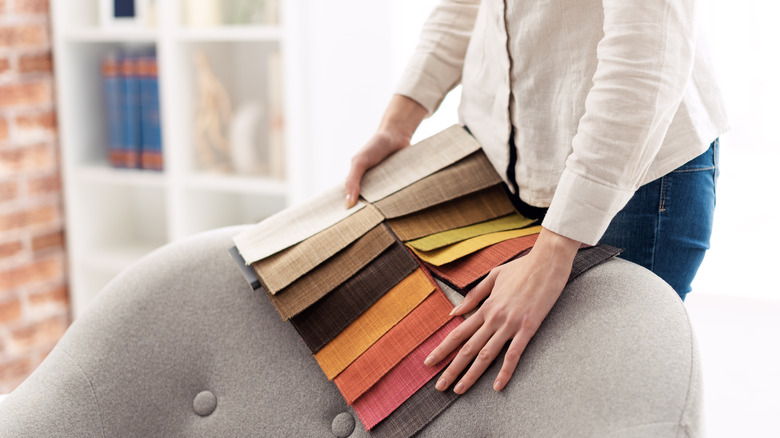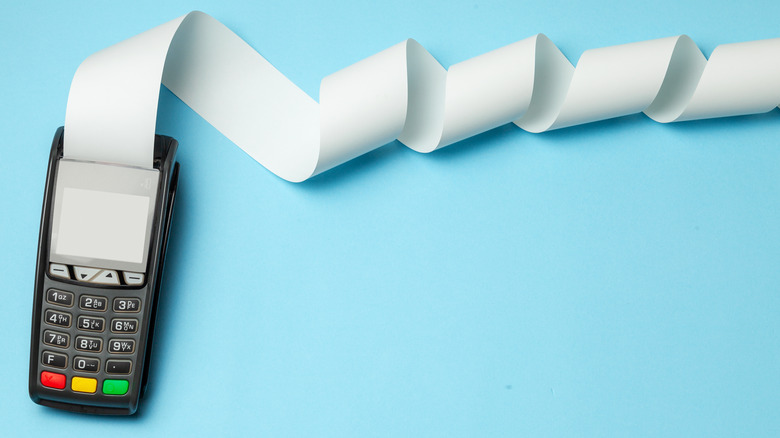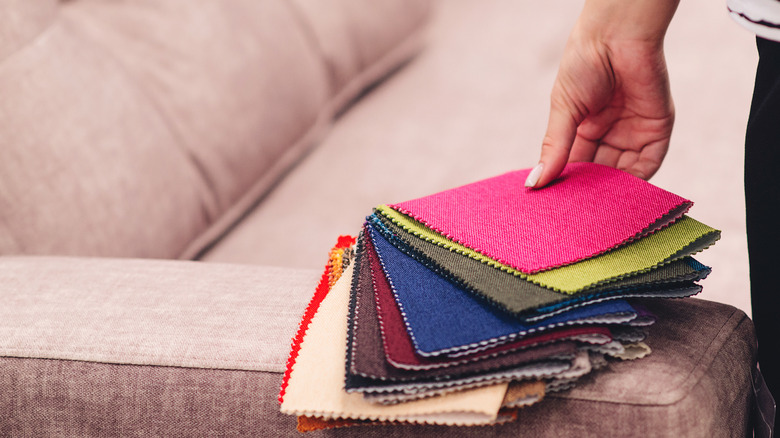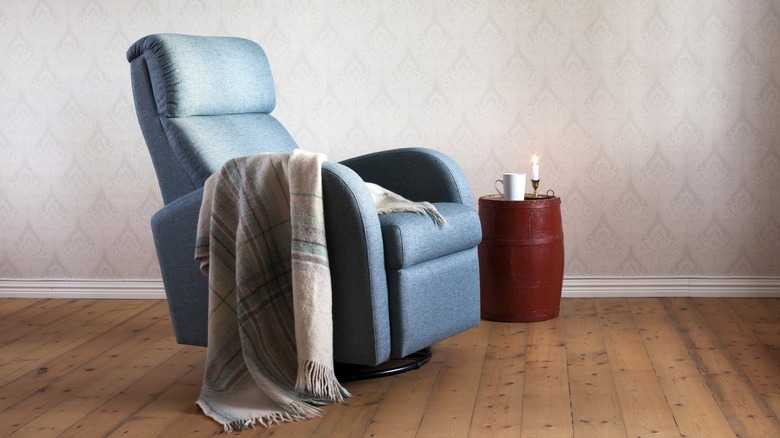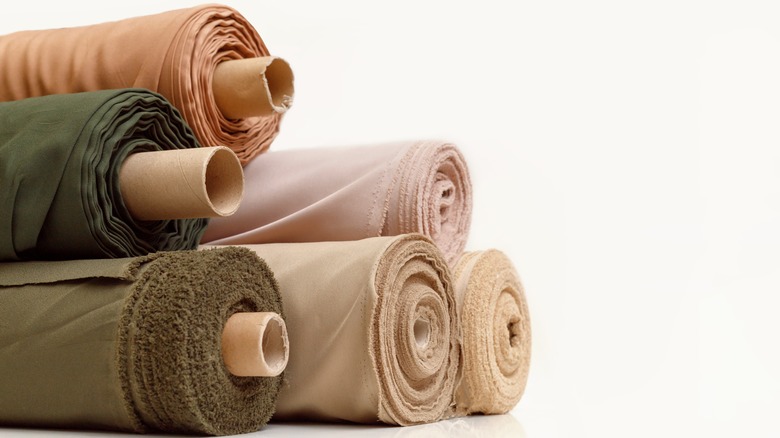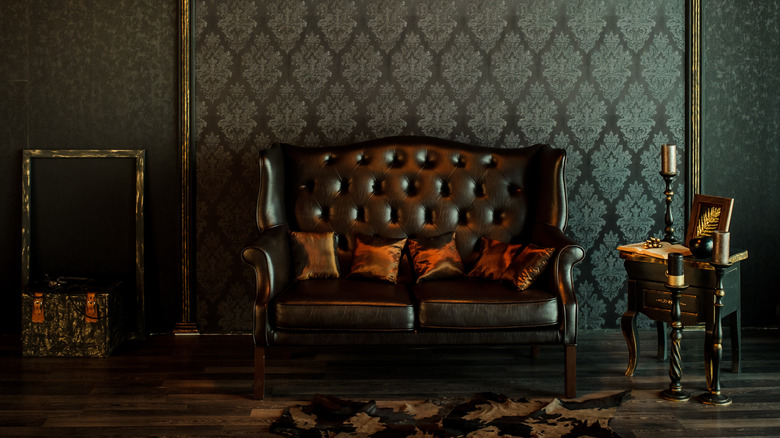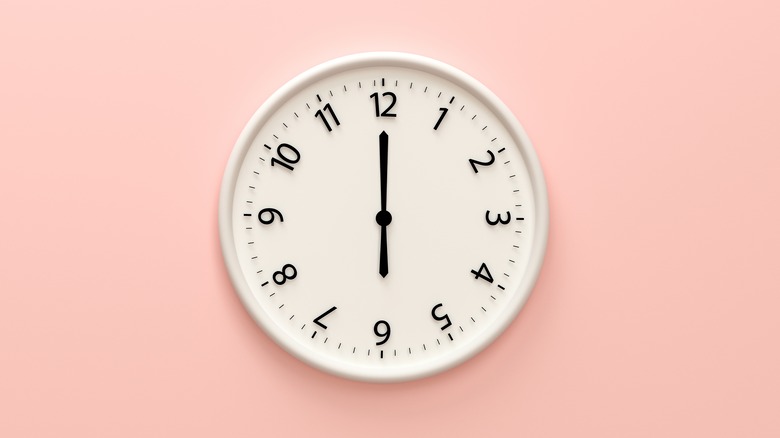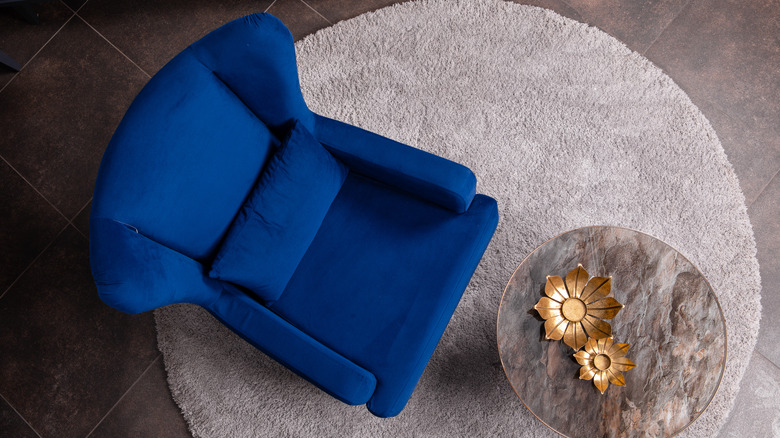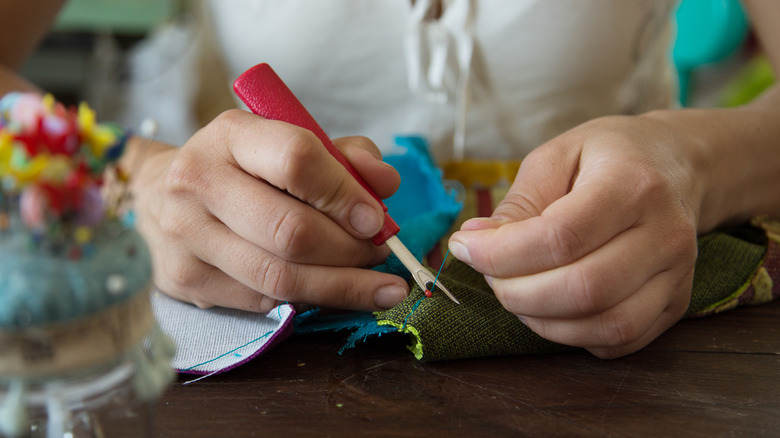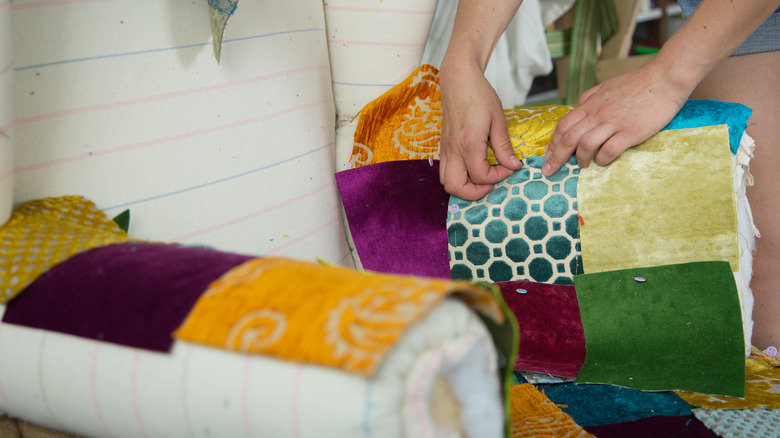Myths About Reupholstering That You Need To Stop Believing
You've likely heard of reupholstering furniture, and maybe you've even dabbled in the art of it! But you probably aren't aware about the intricate ins and outs of reupholstery, of which there are many. For starters, let's begin with what furniture reupholstery is. HomeQuestionsAnswered provides some insight into this. As explained on their site, furniture reupholstery refers to the act of refinishing pieces of furniture. Most commonly, chairs and sofas are the pieces that are reupholstered. However, a number of other items can be reupholstered, including tufted ottomans, benches, stools, patio furniture, chaises, and other furniture that's made with fabric. This is most usually done when a piece of furniture is old or damaged, but you may choose to reupholster if you simply want to mix it up with new fabric to better match your style or space.
The process of reupholstery includes repairing any blemishes or imperfections on the furniture, including fixing damages to the webbing and padding. This project may, at times, be confused with the act of putting a slipcover over a piece of furniture. While this does change the fabric, it's a very different process, as reupholstery requires skills such as sewing, restoring, and renovating. There's quite a bit that goes into reupholstery, and because of that, a lot of myths surrounding the topic are commonly held. Let's bust some of those myths to provide a more holistic look at how reupholstery really works.
It's cheaper than buying something new
Many furniture owners and shoppers believe that reupholstering a piece of furniture is bound to be cheaper than buying something new. The thought makes sense — if you already own the piece, how much could it possibly cost to spruce it up, right? Well, this commonly held belief isn't always untrue, and in fact, it's also sometimes entirely false. Often, reupholstering a piece of furniture could end up costing quite a bit more than it would if you just purchased something brand new — not to mention the fact that the price of reupholstered furniture has gone up.
Kim's Upholstery discusses how much it costs to reupholster a chair, which is a piece that's commonly redone via this type of restoration. This upholstery expert shares that many times, customers are surprised by the high quote they receive regarding their chair project. But, quite a bit goes into the process, which contributes to the hefty price tag. The site uses the example of a quote of $1,500 to reupholster a chair. The explanation for the cost accounts for fabric, which could cost up to $700 depending on different factors, such as quality. It also accounts for new padding and related supplies, running you between $100 to $200. Finally, a charge for labor is included in the price, costing up to $800. Labor includes tasks like tearing down the chair as it currently is, any necessary frame repair, working on new support systems and retying springs, and then finally adding the new padding and fabric. You see, you could likely get a new chair for under $1,500, unless you were looking for something highly specialized. This is a prime example of the fact that reupholstery isn't always the more affordable option.
It's simple and easy to do
It's understandable that with all the DIY tutorials out there, as well as all the videos on social media of people reupholstering furniture, it's easy to believe that it's a really simple and straightforward process. However, nothing could be further from the truth! When it comes to reupholstering a piece of furniture, it is laborious and time consuming. In fact, even the smallest of projects can be quite an undertaking.
Carr's Corner has a handy guide of how long different upholstery projects typically take, which demonstrates that they're not such a breeze of a project. The site explains that for an average chair reupholstery, the time to remove and replace the fabric usually takes between eight and 10 hours. That's a solid amount of time! But that's not all — the removal and replacement of a coil spring seat may be required, which is noted to take between two and a half hours to four hours. With that being said, the entire chair project could take anywhere between eight and 14 hours, which is not a short duration to spend on one project.
A sofa is even more time consuming, as you could have guessed. Removing and replacing sofa fabric takes between 16 and 22 hours. If the replacement or repair of a coil spring seat is required, it will take between four to eight hours for most individuals. That equates to a sofa reupholstery project taking between 16 to 28 labor hours. This doesn't include the time and effort it takes to plan out the project and gather supplies, either. Plus, if accessories like trim, buttons, skirts, or borders are to be added, that will also ramp up the labor time. If we can take away anything, it's like reupholstering furniture takes time, patience, and expertise! It's an artful process, and the right attention and care has to be put into it for it to be done well.
It can always be a DIY project
Again, thanks to videos on platforms like YouTube, or circulating on social media, it's understandable to believe that a reupholstery project is always something you can DIY. However, that is certainly not always the case. In fact, sometimes it's a job better left to the professionals.
Carmen's Custom Window Treatments shed some light on why, more often than not, it's important to go with the work of a professional over doing the reupholstery job yourself. As the article notes, reupholstery is somewhat of an art form, and it requires quite a bit of training and practice. The pitfalls of an inexperienced person taking on a reupholstery project begins with deconstructing the item and priming it for the new fabric. At this stage, those who are not used to the process are prone to causing cracks, splits, strips, or other kinds of damage to the structure of the piece. Sometimes, this damage can be irreversible and could even render the piece of furniture unusable going forward.
Furthermore, a professional upholsterer has a keener eye when it comes to assessing a piece of furniture and determining the current condition of various pieces of the structure. That will decipher how much needs to be done to the piece, particularly to the cushioning. Professionals know to look out for mold and can spot deteriorated foam, which is not always possible for the average DIYer.
Every piece is worth reupholstering
Another common misconception about redoing furniture in this manner is that every piece is worth reupholstering. Unfortunately, some pieces of furniture are not worth the cost and effort that will go into reupholstering it, and you're better off starting with something new, or hunting for something vintage or antique that you like. Carla Aston Designed shared a handy guide to how you can determine if a particular piece of furniture is worth reupholstering. The blog explains that first, you need to evaluate whether or not you truly love the style of the piece. While it's simple to change the look with different fabric, if you don't like the style of it — including its size — then it's probably not worth reupholstering.
Next, you want to determine what the sentimental value of the piece is to you. Perhaps an armchair is a family heirloom that belonged to someone special. If that's the case, then you'll likely do anything to keep it in your home and life! You'll also want to think about how old the furniture piece is. If it was made over 30 years ago, you may be surprised that it may be well worth reupholstering. This is because furniture made during that time period was manufactured differently, and usually made with solid wood frames. On the other hand, if the frame is made of plywood, it's likely not worth the cost of reupholstering.
Any fabric will work
When embarking on a reupholstery journey, many DIYers assume that any fabric will work for the project. This isn't the case, and it's important to evaluate what fabric will work best on a project by project basis to ensure that your efforts are successful. After all, you don't want to waste your time, money, and energy on a project that doesn't pan out because you use the wrong fabric!
Upcycle My Stuff provides a useful guide of which fabrics you should use for different reupholstery endeavors. The site explains that you have to consider a few factors. First, you want to think through how much use the piece of furniture will get once it's redone, as well as who it will be used by. For instance, a couch that will be heavily used by little ones and pets will likely demand a more forgiving fabric that can be easily cleaned than a piece that will receive very little use. Also, consider what factors are most important to you regarding the fabric. Are most concerned with aesthetics, cost, or longevity?
If you're interested in a resilient fabric that you can easily clean, cotton is always a solid choice. Linen is another popular fabric used for reupholstery, as it's known for its neutral look and soft touch. Finally, polyester fabric can stand the test of time and is smooth as well as easy to clean.
The cost just comes down to fabric
Many people erroneously think that the cost of reupholstery comes down to simply the cost of the fabric. Nothing could be further from the truth! In fact, a variety of factors play into the cost of reupholstering a piece of furniture. Lay-Z-Boy shares the different factors that go into the cost of a reupholstery project — and you may be surprised at just how many factors there are.
First, you have the size of the piece. The bigger the piece, the higher the price will be (most likely). Next up is the quality of the fabric you select to be used. Obviously a more luxe fabric is going to run you a higher cost than something more affordable. Another factor that plays into the cost is how many repairs are needed. Under the original fabric, there could be repairs needed that you weren't expecting, which will raise the cost. Believe it or not, the wood finish on the piece of furniture can also affect the pricing in different ways. Finally, the labor needed to rehab the piece goes into the cost. A more complex project takes more time and energy and will cost more than something straightforward and simple.
It's really just meant for family heirlooms
There are so many reasons to reupholster a piece of furniture. However, people frequently have the idea that doing so is only for pieces that you would consider a family heirloom. Let's discuss some of the reasons you may want to reupholster a piece of furniture besides just wanting to pass it down to the next generation.
Alan Henderson & Sons Upholstery offers some insight into this. The first thing the site notes is simply the ability to preserve a piece of furniture once it's become a bit worn out. Even if it needs some TLC, reupholstery can save a piece that you've loved for years, and breathe new life into it rather than needing to throw it out. Plus, this is great for the environment and reduces consumerism, which is in fact another cited reason for why to go with reupholstery rather than buying new. Another common motivation behind reupholstering that strays from being sentimental is to accommodate a style change without demanding the need for a whole new piece of furniture. If you're looking to go with a new color scheme or entirely different aesthetic, reupholstery can aid in that with ease.
Reupholstery is a quick project
While many DIY projects are a quick turnaround, reupholstery is one of those that is not always quick to carry out. The same can be said when you use a professional — you shouldn't always expect to have your piece back and finished right away. South West Upholstery shares how long you can expect it to take for a sofa to be reupholstered. In the case of this company, it can take three to four weeks to even go through all the preliminary steps before they physically get to work on the sofa.
Let's walk through the process: First, an upholstery company will give you a price estimate of how much the project will cost. Once you've decided to move forward with the project, you'll need to choose the material and fabric you want used for the reupholstery. Then, the pros will strip the piece of its current fabric and make necessary repairs and padding replacements. This includes tweaking the frame, repairing springs, and so on. After that, it's time to cover the sofa with the new fabric to achieve that whole new look. Finally, finishing touches are put onto the piece and it'll be returned to you. As you can see, quite a bit goes into the process, which means it's not something that can be turned around in a flash.
Taking the original fabric off will be quick and easy
You can imagine that taking the original fabric off of a chair, sofa, or ottoman will be easy and even kind of fun. However, it's not as simple as just ripping it off haphazardly. Home Sewn Life shares what you will need to take off the original fabric. These materials include a flat head screwdriver, needle-nose pliers, Sharpie, and a camera so that you can document the process, which will help you when you go to replace the fabric.
As you go through the process, you'll want to carefully remove the fabric in as close to one entire piece or panel as possible for each section. Make sure that you make note of how each piece is stapled onto the furniture. This is where taking pictures really comes in handy — it's all about allowing yourself the chance to simplify the process going forward! Label each piece you take off to denote what order they were in, that way you can trace their shape on your new fabric. This gives you the perfect template to use.
It'll be a seamless process
People tend to think that reupholstering a piece of furniture is so straightforward and simple that it'll be a seamless process from start to finish. In reality, there are bound to be bumps along the way, as there are with many DIY projects. Even professionals will experience snafus as they reupholster a piece!
Nesco Upholstery & Design explains some common mistakes that people encounter as they reupholster a piece of furniture. The first notable mistake is compromising when it comes to quality in the name of saving money. While it's also smart to shop around for a good deal, ignoring quality is not a great idea, because you'll end up paying for it in the end. That's because using fabric of lesser quality means that the piece will not stand the test of time nearly as well. Another commonly made mistake is going too trendy in the style you choose for your piece. You're reupholstering your furniture because you want to have it for years to come! Going too trendy may prohibit the piece from aging well and being something you'll want in your home in the long run.
Recovering and reupholstering are one in the same
It's not uncommon for people to use the terms "recover" and "reupholster" interchangeably, but they actually have their differences. J&R Upholstery and Blinds, Inc. distinguishes the two, noting that they both, in fact, refer to replacing fabric. However, the term "recovering" relates to a much more minor project in most cases, compared to reupholstery. You can "recover" something small-scale, like a throw pillow — or in other words, something that's not technically furniture. Recovering items could mean something as simple as sewing up a tear or even cleaning the item to restore its original luster. On the other hand, reupholstering refers to replacing fabric on larger-scale pieces of furniture. These projects are typically much more complex and take a lot more skill, time, and material to complete. It involves completely ripping off the original fabric and replacing it, making it a much more involved endeavor.
